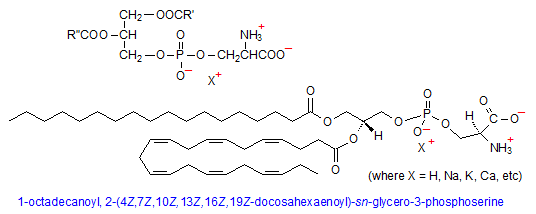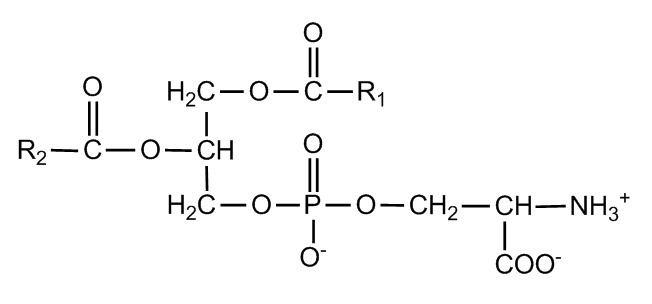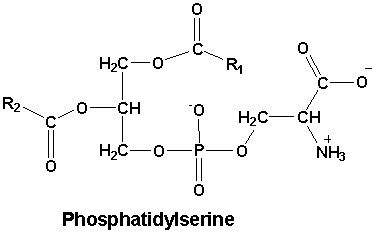Formula C13H24NO10P | Molar mass 385.304 g/mol | |
 | ||
Phosphatidylserine explained
Phosphatidylserine (abbreviated Ptd-L-Ser or PS) is a phospholipid and is a component of the cell membrane. It plays a key role in cell cycle signaling, specifically in relationship to apoptosis.
Contents
- Phosphatidylserine explained
- Structure
- Cell signaling
- Coagulation
- Biosynthesis
- Health claims
- Cognition
- Safety
- References

Structure

Phosphatidylserine is a phospholipid (more specifically a glycerophospholipid). It consists of two fatty acids attached in ester linkage to the first and second carbon of glycerol and serine attached through a phosphodiester linkage to the third carbon of the glycerol.
Phosphatidylserine coming from plants and phosphatidylserine coming from animals differ in fatty acid composition.
Cell signaling

Phosphatidylserine(s) are actively held facing the cytosolic (inner) side of the cell membrane by the enzyme flippase. However, when a cell undergoes apoptosis, phosphatidylserine is no longer restricted to the cytosolic side by flippase. Instead scramblase catalyzes the rapid exchange of phosphatidylserine between the two sides. When the phosphatidylserines flip to the extracellular (outer) surface of the cell, they act as a signal for macrophages to engulf the cells.
Coagulation
Phosphatidylserine plays a role in blood coagulation (also known as clotting). When circulating platelets encounter the site of an injury, collagen and thrombin -mediated activation causes externalization of phosphatidylserine (PS) from the inner membrane layer, where it serves as a pro-coagulant surface. This surface acts to orient coagulation proteases, specifically tissue factor (TF) and factor VII (the tenase complex), facilitating further proteolysis, activation of factor X, and ultimately generating thrombin.
In the coagulation disorder Scott syndrome, the mechanism in platelets for transportation of PS from the inner platelet membrane surface to the outer membrane surface is defective. It is characterized as a mild bleeding disorder stemming from the patient's deficiency in thrombin synthesis.
Biosynthesis
Phosphatidylserine is biosynthesized in bacteria by condensing the amino acid serine with CDP (cytidine diphosphate)-activated phosphatidic acid. In mammals, phosphatidylserine is produced by base-exchange reactions with phosphatidylcholine and phosphatidylethanolamine. Conversely, phosphatidylserine can also give rise to phosphatidylethanolamine and phosphatidylcholine, although in animals the pathway to generate phosphatidylcholine from phosphatidylserine only operates in the liver.
Health claims
A panel of the European Food Safety Authority concluded that a cause and effect relationship cannot be established between the consumption of phosphatidylserine and "memory and cognitive functioning in the elderly”, “mental health/cognitive function” and “stress reduction and enhanced memory function”. The reason is that bovine brain cortex- and soy-based phosphatidylserine are different substances and might, therefore, have different biological activities. Therefore the results of studies using PS coming from different sources cannot be generalized.
Cognition
In May, 2003 the Food and Drug Administration gave "qualified health claim" status to phosphatidylserine thus allowing labels to state "consumption of phosphatidylserine may reduce the risk of dementia and cognitive dysfunction in the elderly" along with the disclaimer "very limited and preliminary scientific research suggests that phosphatidylserine may reduce the risk of cognitive dysfunction in the elderly. FDA concludes that there is little scientific evidence supporting this claim."
The FDA declared that "based on its evaluation of the totality of the publicly available scientific evidence, the agency concludes that there is not significant scientific agreement among qualified experts that a relationship exists between phosphatidylserine and reduced risk of dementia or cognitive dysfunction". The FDA also noted "Of the 10 intervention studies that formed the basis of FDA's evaluation, all were seriously flawed or limited in their reliability in one or more ways", concluding that "most of the evidence does not support a relationship between phosphatidylserine and reduced risk of dementia or cognitive dysfunction, and that the evidence that does support such a relationship is very limited and preliminary".
Early studies of phosphatidylserine on memory and cognition used a supplement which isolated the molecule from the bovine brain. Currently, most commercially available products are made from cabbage or soybeans because of concerns about mad cow disease in bovine brain tissue. These plant-based products have a similar, but not identical chemical structure to the bovine derived supplements; for example, the FDA notes "the phosphatidylserine molecule from soy lecithin contains mainly polyunsaturated acids, while the phosphatidylserine molecule from bovine brain cortex contains mainly saturated and monounsaturated fatty acids and long-chain polyunsaturated fatty acids".
A preliminary study in rats in 1999 indicated that the soy derived phosphatidylserine supplement was as effective as the bovine derived supplement in one of three behavioral tests. However, clinical trials in humans found that "a daily supplement of S-PS [soybean-derived phosphatidylserine] does not affect memory or other cognitive functions in older individuals with memory complaints."
Safety
Traditionally, PS supplements were derived from bovine cortex (BC-PS). However, due to the risk of potential transfer of infectious diseases, soy-derived PS (S-PS) supplements have been used as an alternative. Soy-derived PS is designated Generally Recognized As Safe by the FDA. A 2002 safety report determined supplementation in elder people at a dosage of 200 mg three times daily to be safe.
